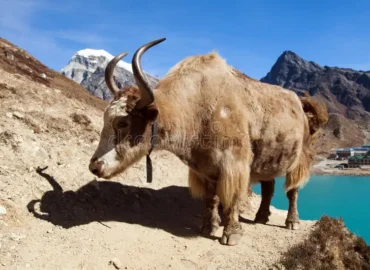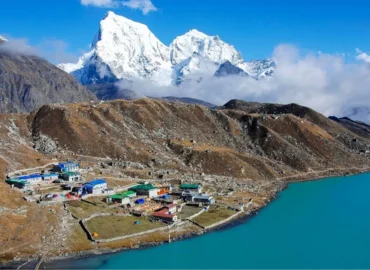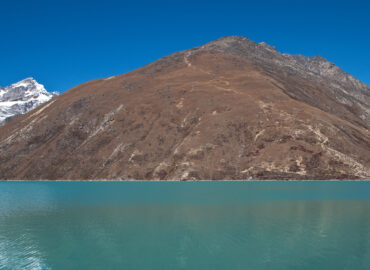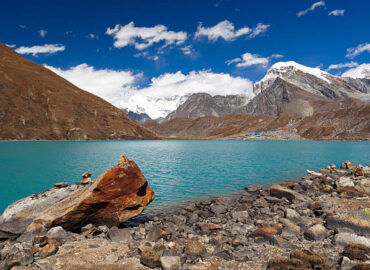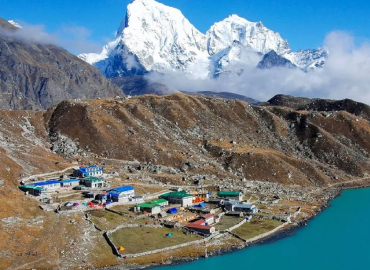- info@destinationholidaytrek.com
- +977-9768913779
- Gokarneshwor-6, Arubari, Kathmandu, Nepal
The Gokyo Valley Trek (5357 Meters)
GOkYO TREK ✨
The Gokyo Valley Trek is one of the most stunning treks in the Everest region, offering spectacular views, serene glacial lakes, and an authentic Sherpa cultural experience. Unlike the crowded Everest Base Camp trail, Gokyo Valley provides a peaceful journey through majestic landscapes and pristine nature.
TREK HIGHLIGHTS:
1. Gokyo Lakes: A series of five turquoise glacial lakes, surrounded by snow-capped peaks.
2. Gokyo Ri: A panoramic viewpoint at 5,357 m, offering breathtaking vistas of Mount Everest, Lhotse, Cho Oyu, and Makalu.
3. Everest Views: Stunning mountain panoramas without the usual crowds.
4.Sherpa Villages: Experience the local culture in Namche Bazaar, Dole, and Gokyo villages.
5.Challenging yet Rewarding: Moderate to strenuous trek, suitable for those with good fitness levels.
WHY CHOOSE THE GOKYO TREK ?
1. Stunning Gokyo Lakes
The trek takes you to the world-famous turquoise Gokyo Lakes, considered the highest freshwater lake system in the world.
2. Best Panoramic View of Everest
From Gokyo Ri (5,357m), you get one of the best 360° Himalayan views — Everest, Lhotse, Makalu, and Cho Oyu all in one frame.
3. Less Crowded Than EBC Trek
Gokyo is a peaceful alternative to the classic Everest Base Camp route, offering quiet trails and a more relaxed trekking experience.
4. Crossing the Longest Glacier
Walk along the Ngozumpa Glacier, the longest glacier in Nepal, a truly unique Himalayan adventure.
5. Rich Sherpa Culture
Experience authentic Sherpa villages, monasteries, and traditional mountain lifestyles.
6. Safe, Scenic & Adventurous
A perfect blend of adventure, natural beauty, and cultural exploration — suitable for trekkers seeking something special beyond EBC.
TRIP FACTS:


📊Difficulty Level: Moderate to Strenuous
🌤️Best Season: Spring (March–May) & Autumn (September–November)
📍Starting / Ending Point: Lukla → Lukla
ITINEARY
-
• Airport pick-up and transfer to hotel
• Trek briefing, equipment check
• Overnight in Kathmandu
• Scenic 35-min flight to Lukla
• Easy trek to Phakding (3–4 hrs)
• Overnight in Phakding
- Cross suspension bridges
• Enter Sagarmatha National Park
• First view of Everest (if weather clear)
• Overnight in Namche
- Short hike to Everest View Hotel / Khumjung
• Explore Sherpa culture museum & market
• Overnight in Namche
Gradual climb via Mong La and Phortse Tenga
• Amazing views of Ama Dablam
• Overnight in Dole
-
• Steady climb through pastures
• Overnight in Machhermo
-
Explore First, Second & Third Gokyo Lakes
• Reach Gokyo Village
• Overnight in Gokyo
-
Sunrise hike to Gokyo Ri for Everest, Lhotse, Makalu views
• Optional hike to 4th Lake & 5th Lake
• Overnight in Gokyo
-
Descend back following same trail
• Overnight in Dole
Trek down to Namche Bazaar
• Overnight in Namche
-
• Final trekking day
• Overnight in Lukla
• Final trekking day
• Overnight in Lukla
• Visit UNESCO sites: Boudhanath, Pashupatinath, Swayambhunath
• Cultural dinner in the evening
• Overnight in Kathmandu
- • Airport drop-off
• Trip concludes
Cost Include
✅Transfers
Airport pick-up and drop-off in Kathmandu
Domestic flights: Kathmandu ↔ Lukla
✅Accommodation
Hotels in Kathmandu (before and after trek)
Tea houses or lodges during the trek
✅Meals
3 meals per day with tea coffe, during the trek (breakfast, lunch, dinner)
✅Trekking Support
Experienced trekking guide
Porter service (1 porter per 2 trekkers)
✅Permits & Fees
TIMS card (Trekkers’ Information Management System)
Sagarmatha National Park Permit
- ✅Safety & First Aid
- First-aid kit and emergency support
- ✅Government Taxes
- All applicable local taxes
Cost Exclude
❌International airfare to/from Nepal
❌Personal trekking gear (boots, jackets, sleeping bags, crampons, etc.)
❌Hot showers, snacks, tea/coffee, and drinks
❌Tips for guides, porters, and staff
❌Personal travel & medical insurance
❌Laundry, phone calls, Wi-Fi, souvenirs, or personal expenses
❌Extra nights due to flight delays or bad weather
❌Emergency evacuation (helicopter or emergency flights)
